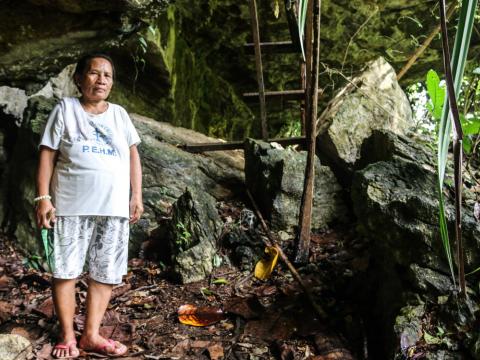Knowledge for life: How caves saved lives in a mega-typhoon

By Jennina Lanza
For Filipinos in many areas of the country, experiencing typhoons are a part of life. Marlita’s family usually packs their valuables and cover them with plastic, hoping they don’t get wet in the event that water enters their home.
When Typhoon Haiyan struck in 2013, many people from 67-year-old Marlita's community chose to stay in their homes rather than moving to evacuation centres.
“When water started to rise and enter our house, we were so scared. We hurried to our neighbour's house; it was the closest high place for us to run to,” shares Marlita.
The storm surge devastated the village - killing some of her neighbours - and destroyed Marlita's house.
THE SUPER STORM CHANGED COMMUNITY REACTIONS TO DISASTER WARNINGS
Since that dreadful day, Marlita and her community have realised the importance of disaster preparedness.
One of the key concerns identified for the community was to ensure safe evacuation places for people. Those that live nearby to a church or school had options. But for those in more remote areas, sustainable evacuation points needed to be established.
IDENTIFYING NATURAL EVACUATION SITES
Community leaders began to think about places that could safely house small groups of people.
One area identified was Saob caves; a tourist destination which used to be a home for people during World War II. Inside, the remains of personal items can still be found; things such as hair combs, kitchen utensils and plates indicating that this was someone’s home many years ago.
“A day before typhoon Hagupit, our village officials went from house to house to warn people that there was a strong typhoon coming; they encouraged people to evacuate,” she says.
When community members heard the announcement, people no longer had the desire to stay at home, remembering the suffering caused by typhoon Haiyan.
PREPARING FOR THE WORST, HOPING FOR THE BEST
They knew they needed to evacuate. Marlita and her family went to the Saob caves.
“We hurriedly prepared things that we needed for evacuation. We brought a few clothes, and food that would last a few days, like canned goods and bananas. We tied the roof of our house down with ropes, and put heavy materials on it so that it wouldn’t blow away,” Marlita adds.
As they walked into the cave, they saw relics from 70 years ago. This made Marlita think about the similarities; how both her and her ancestors used caves as protection from disasters.
"Many areas around the coast were damaged, but we were safe in the cave."
“My family, together with 15 other families, stayed in the cave the night typhoon Hagupit visited Samar. We felt secure from wind and water; it is really high up so water would not be able to reach us, and there is no chance of being blown away. Many areas around the coast were damaged, but we were safe in the cave,” she tells.
“Thankfully, we have modern technology that is communicated to our village leaders and they warn us when disasters are coming, so we can pack up our valuables and head for safety well ahead of time,” she says.
Marlita feels safe and assured knowing that Saob cave is their evacuation point.
She and her family will continue to practice the same kind of preparedness for future disasters.